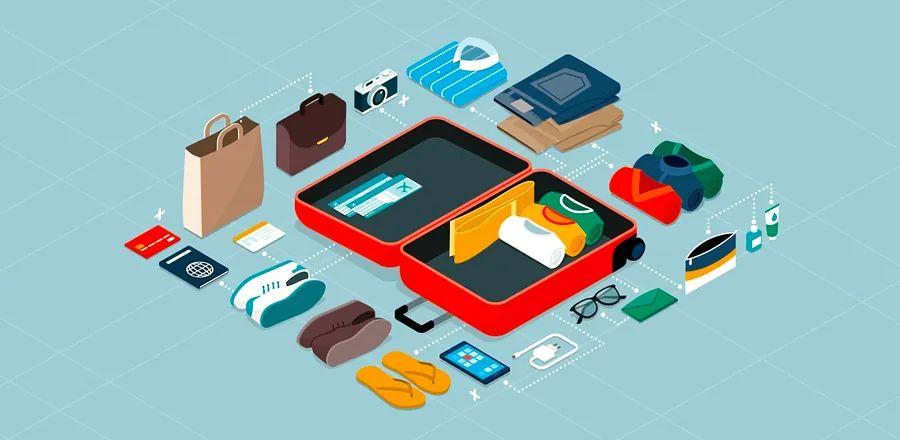Mastering the Art of Packing a Suitcase Like a Flight Attendant

My mother has always been a packing expert. Watching her manage a move, sort through a heap of paperwork, or fit four kids, two adults, and two weeks’ worth of camping gear into a minivan is like witnessing a martial arts master in action. So when she became a flight attendant for a regional airline over 14 years ago, it was clear she would soon excel at the skill of living out of a suitcase.
Here are 10 lessons she’s picked up after packing and unpacking her suitcase more than 4,000 times (yes, she keeps track).
1. Create a packing list to prevent overpacking
"It can be tough to slim down what goes into your suitcase, but it's always wise to steer clear of overpacking. If making a packing list feels daunting, start by laying out everything you think you might need. Then, be realistic about what you'll actually require—and remove anything that isn't essential from the selection."
2. Discover the ideal bag for your journey
"After over 13 years as a flight attendant, I've learned to value bags with 360-degree spinning wheels and convenient external pockets. Whether you need sleek carry-on luggage or a larger suitcase for check-in, I've found that compartmentalized rolling bags are the ultimate solution for saving space and traveling effortlessly."
3. Roll your clothes to maximize packing space
"Packing clothes flat can often lead to wasted space in your suitcase. Rolling garments allows them to fit snugly into the corners of your luggage, and utilizing packing cubes or compression bags not only keeps you organized but also conserves a significant amount of space. Plus, rolling helps prevent wrinkles. While you might still need to fold bulkier items (like pants), rolling most of your clothes ensures you make the most of every inch."
4. Keep your toiletries organized for easy access
"I always bring along three different pouches for my toiletries. One contains my essential shower and grooming items (like deodorant, razor, and face lotion), another holds my toothbrush and toothpaste, and the last one is for my makeup. This organization helps me easily find what I need and allows me to pack items away as I finish using them in the morning."
5. Ensure you have all irreplaceable items before departing
"During my first five years in this role, I wouldn’t leave home—or my hotel—without meticulously checking my packing list. Now, I simply ask myself, 'What are the items I can’t replace or do without?' For me, the essentials include my work ID, passport, glasses, phone, laptop, and jewelry. Everything else can be replaced, though I'd certainly prefer not to lose it."
6. Create a consistent packing and unpacking routine
"When I arrive at my hotel room—whether it's midnight or two in the afternoon—I always unpack and repack in the same manner. For instance, I keep a small dish in the external pocket of my suitcase to immediately place my jewelry. I also pull out my toiletry bags, phone chargers, and anything I’ll need for the following day."
"In the morning, I follow a reverse routine. Right after I get out of bed, I unplug my phone, store the charger away, and tidy up my nightstand so I won't have to revisit that area later. I put my pajamas away before showering, not afterward. This system helps me avoid rummaging through my bag to make sure I haven't forgotten anything. I've left a shirt behind in the past because I tossed it on the bed and forgot to check under the covers—never again!"
7. Create visual cues to prevent leaving items behind
"I use a dedicated bag for my cords and chargers. When I unpack, I pull out all the chargers I need and leave this bag on the dresser with my room key. This way, when I'm packing up in the morning, I have a visual reminder: 'Don't forget your phone cord.'"
8. Master the art of packing Tetris
"I place my toiletry bags on the left side, near the top of my suitcase, so I can access them right away when I reach the hotel. No matter how careful you are with liquids, sometimes cabin pressure can cause caps to pop off. This packing method prevents unwanted spills. I also keep heavier items on the left side to balance the weight and avoid a top-heavy bag. Always secure liquids in a plastic or resealable bag for added protection."
9. Label your bag, even if you never plan to check it
"With so many similar-looking bags out there, I use a seasonal ribbon system to set mine apart. I either buy some ribbon from the fabric store or repurpose an old scarf and tie it on. Sure, you could get fancy luggage tags, but many of those can look alike too! While it’s rare, someone occasionally walks away with the wrong bag."
10. Essential travel items you shouldn’t forget
"I always pack a reusable water bottle to keep hydrated while traveling. For liquid toiletries, I love the GoToob Travel Bottles (starting at $8) because they have a wide mouth for easy filling. They come in various sizes, are soft and squeezable, so they shrink as you use them. Plus, they have a twist label on top to identify the contents and you can easily change it later if needed."
"My mophie powerstation ($45) portable battery is a game changer. You can charge it using your laptop with your phone cord, and it retains a charge for a week or two if not in use. It’s compact, lightweight, and charges your phone super quickly."
"I always keep my Tide stain sticks ($8) handy. I once managed to remove red wine from a passenger’s white coat using one. They’re incredible!"
This article was first published online in December 2016 and was last updated on September 27, 2024, to reflect the most current information.

1

2

3

4

5
Evaluation :
5/5